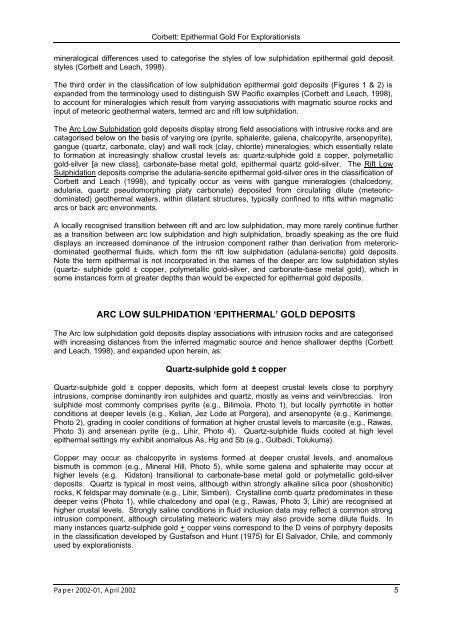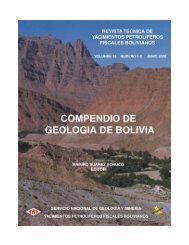Exploraciones por oro epitermal
Create successful ePaper yourself
Turn your PDF publications into a flip-book with our unique Google optimized e-Paper software.
Corbett: Epithermal Gold For Explorationists<br />
mineralogical differences used to categorise the styles of low sulphidation epithermal gold deposit<br />
styles (Corbett and Leach, 1998).<br />
The third order in the classification of low sulphidation epithermal gold deposits (Figures 1 & 2) is<br />
expanded from the terminology used to distinguish SW Pacific examples (Corbett and Leach, 1998),<br />
to account for mineralogies which result from varying associations with magmatic source rocks and<br />
input of meteoric geothermal waters, termed arc and rift low sulphidation.<br />
The Arc Low Sulphidation gold deposits display strong field associations with intrusive rocks and are<br />
catagorised below on the basis of varying ore (pyrite, sphalerite, galena, chalcopyrite, arsenopyrite),<br />
gangue (quartz, carbonate, clay) and wall rock (clay, chlorite) mineralogies, which essentially relate<br />
to formation at increasingly shallow crustal levels as: quartz-sulphide gold ± copper, polymetallic<br />
gold-silver [a new class], carbonate-base metal gold, epithermal quartz gold-silver. The Rift Low<br />
Sulphidation deposits comprise the adularia-sericite epithermal gold-silver ores in the classification of<br />
Corbett and Leach (1998), and typically occur as veins with gangue mineralogies (chalcedony,<br />
adularia, quartz pseudomorphing platy carbonate) deposited from circulating dilute (meteoricdominated)<br />
geothermal waters, within dilatant structures, typically confined to rifts within magmatic<br />
arcs or back arc environments.<br />
A locally recognised transition between rift and arc low sulphidation, may more rarely continue further<br />
as a transition between arc low sulphidation and high sulphidation, broadly speaking as the ore fluid<br />
displays an increased dominance of the intrusion component rather than derivation from meteroricdominated<br />
geothermal fluids, which form the rift low sulphidation (adularia-sericite) gold deposits.<br />
Note the term epithermal is not incor<strong>por</strong>ated in the names of the deeper arc low sulphidation styles<br />
(quartz- sulphide gold ± copper, polymetallic gold-silver, and carbonate-base metal gold), which in<br />
some instances form at greater depths than would be expected for epithermal gold deposits.<br />
ARC LOW SULPHIDATION ‘EPITHERMAL’ GOLD DEPOSITS<br />
The Arc low sulphidation gold deposits display associations with intrusion rocks and are categorised<br />
with increasing distances from the inferred magmatic source and hence shallower depths (Corbett<br />
and Leach, 1998), and expanded upon herein, as:<br />
Quartz-sulphide gold ± copper<br />
Quartz-sulphide gold ± copper deposits, which form at deepest crustal levels close to <strong>por</strong>phyry<br />
intrusions, comprise dominantly iron sulphides and quartz, mostly as veins and vein/breccias. Iron<br />
sulphide most commonly comprises pyrite (e.g., Bilimoia, Photo 1), but locally pyrrhotite in hotter<br />
conditions at deeper levels (e.g., Kelian, Jez Lode at Porgera), and arsenopyrite (e.g., Kerimenge,<br />
Photo 2), grading in cooler conditions of formation at higher crustal levels to marcasite (e.g., Rawas,<br />
Photo 3) and arsenean pyrite (e.g., Lihir, Photo 4). Quartz-sulphide fluids cooled at high level<br />
epithermal settings my exhibit anomalous As, Hg and Sb (e.g., Gulbadi, Tolukuma).<br />
Copper may occur as chalcopyrite in systems formed at deeper crustal levels, and anomalous<br />
bismuth is common (e.g., Mineral Hill, Photo 5), while some galena and sphalerite may occur at<br />
higher levels (e.g. Kidston) transitional to carbonate-base metal gold or polymetallic gold-silver<br />
deposits. Quartz is typical in most veins, although within strongly alkaline silica poor (shoshonitic)<br />
rocks, K feldspar may dominate (e.g., Lihir, Simberi). Crystalline comb quartz predominates in these<br />
deeper veins (Photo 1), while chalcedony and opal (e.g., Rawas, Photo 3; Lihir) are recognised at<br />
higher crustal levels. Strongly saline conditions in fluid inclusion data may reflect a common strong<br />
intrusion component, although circulating meteoric waters may also provide some dilute fluids. In<br />
many instances quartz-sulphide gold + copper veins correspond to the D veins of <strong>por</strong>phyry deposits<br />
in the classification developed by Gustafson and Hunt (1975) for El Salvador, Chile, and commonly<br />
used by explorationists.<br />
Paper 2002-01, April 2002 5
















